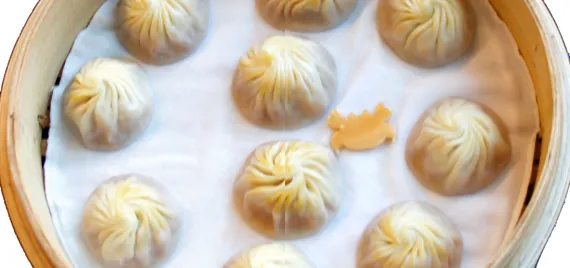This crab-based baozi brings you the salty taste of the sea
There is no feeling quite like picking up a fresh dumpling on the verge of bursting out of its semi-transluscent skin and nibbling a small hole in the skin to suck out the devilishly good filling: orgasmic. And while it’s a big wide world of dumplings out there, the crabby goodness of 小笼包 (xiǎolóngbāo) is surely king in the dumpling stakes.
Literally “small steaming basket buns”, xiǎolóngbāo is not your average dumpling. This type of bun bears the typical characteristics of Jiangnan (immediate south of the lower reaches of Yangtze River) cuisine, boasting intricate folds, a delicate size, the softest yet juicy texture, and an incredible explosion of salacious flavors. Whether it’s pork, bamboo shoots, or shrimp, the filling is always minced to ensure softness and saturation, epitomizing the Jiangnan taste.
If xiǎolóngbāo could be crowned the king of bāozi, then crab roe xiǎolóngbāo is surely the king of kings. After cooking slowly on a low heat, the essence of the crab, its meat, and roe, exudes the rich smell of seafood and a golden shine with shades of orange. Only then can it be used with ground pork for the filling. Besides the smell and color of the filling, the sensation of eating a xiǎolóngbāo is heightened by its extremely creamy texture.
As the epitome of Chinese bāozi and mántou culture, xiǎolóngbāo didn’t come into being until the Qing Dynasty (1616-1911). Given the varieties of xiǎolóngbāo in different cities in Zhejiang, Jiangsu, and Shanghai, there is much dispute as to how the thin-skinned juicy mutation came into being. In Wuxi and Changzhou, both famous for their crab roe xiaolongbao, the history of the dish is traced back to as early as the 1700s, when Emperor Qianlong (乾隆) was documented to have tasted this divine ethnic snack. A Changzhou saying demonstrates just how much esteem these tasty little buns carry: “It’s better to let people wait for the buns, than let the buns wait for people” (宁可人等馒头,不可馒头等人).
The famous Nanxiang xiǎolóngbāo (南翔小笼包) on the other hand, was born when a bakery in the ancient town of Nanxiang (now a district in Shanghai) decided to reinvent traditional buns and give them a creative spin. The large size and the thick skin of mantou was modified, and the chef invented a method of adding frozen broth into the filling so that the brothy flavor would be locked into the wrapping when steamed.
When done right, xiǎolóngbāo should be what the folk saying describes: “when you pick up a bun, the thin skin will not break; the bottom will not leak; the creamy broth will fill your whole mouth; and the taste is exquisite yet not greasy.” (夹起 不破皮,翻身不漏底,一吮满口卤,味鲜不油腻。) In addition, their appearance also constitutes a sort of artform. It takes great skill to make the xiǎolóngbāo that food lovers cannot live without. Chef Zhan Zhiming from the Michelin Star restaurant Din Tai Feng says that, in order to qualify as a true xiǎolóngbāo chef, an apprentice needs to undergo three to six months of training to master the techniques of rolling the dough into thin wrapping and folding the stuffing into the wrappers, to achieve a translucent, strong, and resistant paper-thin skin with 18 delicate folds for each bun.
The dining experience ends as you pop the last xiǎolóngbāo down your throat, but it starts with the wait. Even in a restaurant, a fresh xiǎolóngbāo takes time. Perfection always does.
Ingredients:
50g flour 面粉
160g ground pork 猪肉馅
80g crab meat with roe 蟹粉肉
75g green onions (chopped) 葱
75g ginger (minced) 姜
45g salt 盐
45g sugar 糖
25ml water 水
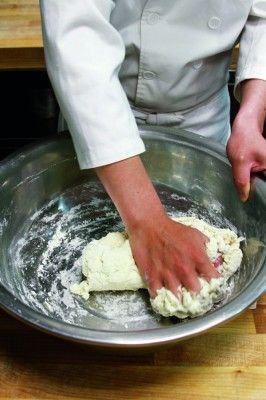
Step 1: For the dough: mix 50g of flour and 25ml of water in a large bowl (2:1 ratio). Stir and knead until the dough becomes smooth and nonsticky. Roll the dough evenly into a long roll and pinch or cut the roll into cylindrical sections about two centimeters in diameter. Seal them with plastic food wrap so no air gets in and set for 20 minutes.
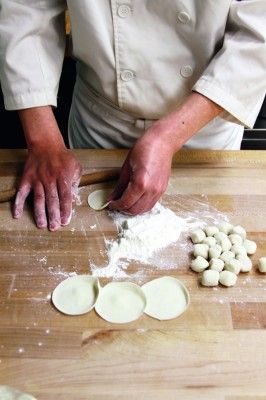
Step 2: Unwrap the dough; use your palm to flatten the chunks. Take one piece, hold the edge and use a rolling pin to further flatten them into circular wrappers approximately six centimeters in diameter with the center thicker than the edges.
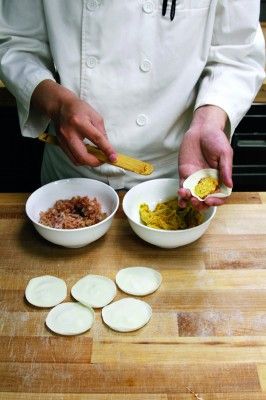
Step 3: For the crab roe filling: cook the crab meat and crab roe on a low heat until you smell the fragrance of the crab and place them in a bowl. Mix ground pork, salt, sugar, chopped green onions, and minced ginger together in a bowl; stir well to make the pork filling. Take a wrapper, drop a tablespoon of pork filling in the center of the concave wrapper and another spoonful of crab meat and roe filling on top.
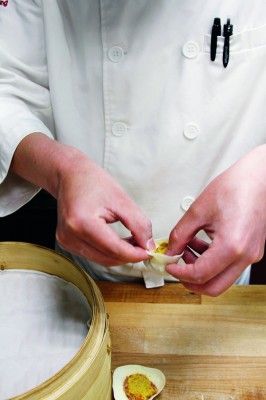
Step 4: Hold the wrapper and let the filling weigh it down naturally, then, use your fingers to carefully fold the edges little by little to create the folds. Don’t let one fold overlap another. The smaller the folds are, the prettier your xiǎolóngbāo will look. Keep folding until the wrapper is entirely sealed. Make sure to seal it tightly.
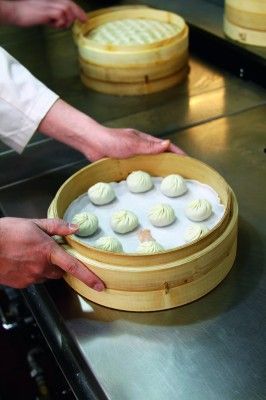
Step 5: Boil a pot of water on a high heat, put the basket of xiǎolóngbāo in the steamer. Leave ample space for each bun to expand. The boiling water should not reach the bottom of the steamer. Steam for seven minutes, when the buns have inflated and become translucent, the batch is done. Serve with ginger slices and vinegar on the side.





